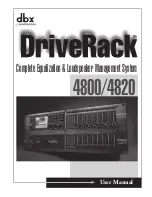
HARDWARE CONTROLS — REAR PANEL
POWER
The EQP-WA requires a 3-pin, grounded IEC cord, and should ship
with the power cord appropriate for the territory in which it is sold.
Voltage is selectable between 115v and 230v operation, from the
rear voltage selector switch. Power input is via a standard fused
IEC power receptacle with built in fuse access, chassis mounted on
the rear of the unit. Power is turned on and off via the toggle switch
labeled ‘ON/OFF’ on the right side of the unit’s front panel.
AUDIO CONNECTIONS
The EQP-WA has both XLR and ¼ inch TRS balanced inputs and
outputs, rear chassis-mounted, operating at line level. Unbalanced
connection is also possible via a ¼ inch TS cable. It is not advised
to connect both
output connectors at once.
5
The rear panel
THE ‘BOOST AND CUT’ TRICK
Another phenomenon well known with this classic type of design is the ability to
apply both boost and cut to a specifi c frequency at the same time. The resulting
eff ect is hardly the type of simple cancellation one might expect. The cue shape
of the boost and cut functions vary slightly, as do their gain potential; so even
matching boost and cut levels by ear can produce a result quite diff erent from
when boost and cut are returned to zero. Some have described this eff ect as
a gentle scooping of the area around the target frequency, with an emphasis
added closer to the center frequency itself. Others describe it as a phase shift
type of eff ect for the target frequency. The result, by any name, is hardly subtle;
and can be used to create emphasis or texture to a specifi ed frequency.
USING THE EQP-WA IN BYPASS MODE
When in bypass mode, the audio signal is still routed through the Cinemag
input transformer, dual vacuum tube stage line amplifi er, and Cinemag output
transformer; and the EQP-WA will output at approximately unity gain relative
to the input level (or within close margin, due to small variations in output
gain from individual vacuum tubes). This design allows the user to take
advantage of an old ‘engineering trick’ known to many successful producers
and recordists, whereby one uses a piece of gear with large transformers and
high voltage tube stages as a ‘pass-through’ device or ‘tube buff er’ following
a mic preamp, console send, or other piece of hardware, adding subtle sheen,
richness, thickness, and harmonic content to an audio signal. This technique
can also be used on program material (complete mixes or subgroups).
10
ENGLISH
NOW LET’S GET STARTED
WARRANTY
TECHNICAL SPECS
A BIT OF HISTORY
WAXING PHILOSOPHICAL
HOOKUP DIAGRAMS
RECALL SHEETS


































